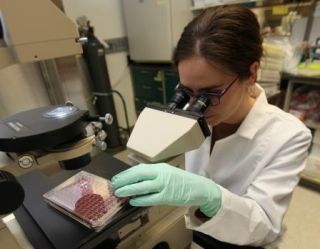Virtual and Complex Tissue Modeling

EPA's Virtual and Complex Tissue Modeling (VCTM) research develops organotypic culture models, engineered microphysiological systems, and in silico agent-based and computational models to test hypotheses of organ-specific toxicity of priority chemicals for major routes of exposure (e.g., inhalation, oral).
These models of biological systems are needed that can be experimentally probed and computationally simulated. Virtual tissue models connect in vitro molecular and pathway perturbations with in vivo tissue- and organ-level observations.
This research includes biological pathways and health endpoints relevant to human toxicity across early and adult life stages to inform risk-based assessments of new and existing chemicals.
On this page:
Research Efforts
Complex Tissue Models
To support tiered toxicity-testing approaches to provide hazard information on priority health effects, EPA researchers and their collaborators are building complex tissue models from human cells grown in the laboratory to form tissue-like structures. These models are a bridge between in vitro and organismal assays that help predict potential health effects from chemical exposures in animal-free laboratory experiments. Learn more about complex tissue models.
Toxicological Tipping Points (Point of No Return)
A key question in modeling the effects of chemical exposure is distinguishing between adaptive responses and those that result in adverse health and environmental outcomes. Biological systems have compensatory processes that protect organisms from stressors like chemical exposure. EPA researchers are figuring out how to determine the “tipping point”, the point when biological systems are unable to recover from or adapt to chemical exposure. EPA researchers are developing mathematical models that will predict perturbation of biological systems and determine when cellular systems are no longer able to recover. When cellular systems are unable to recover, chemical exposures could lead to adverse outcomes such as cancer. Learn more about tipping point analyses.
Virtual Tissue Models
EPA researchers and their collaborators are building computer models to investigate the effects of chemical exposures on human development. Building these models begins with knowledge of molecular biology pathways (a series of interactions among molecules in a cell that leads to a certain product or a change in a cell) to represent embryonic development at the cell, tissue, and organ level. ToxCast high-throughput screening data is then used to predict which chemicals may disrupt developmental processes leading to adverse outcomes including birth defects and behavioral disorders.
Supporting Children’s Environmental Health Research
Environmental exposures that impact health can occur before conception and during pregnancy, infancy, childhood, and adolescence. These exposures can potentially lead to long-term effects on health, development, and risk of disease across life stages. EPA researchers use Virtual Embryo models to simulate biological interactions observed during development and predict when chemicals disrupt key biological events in pathways that are thought to lead to adverse effects. Learn more about EPA's children's health research.
